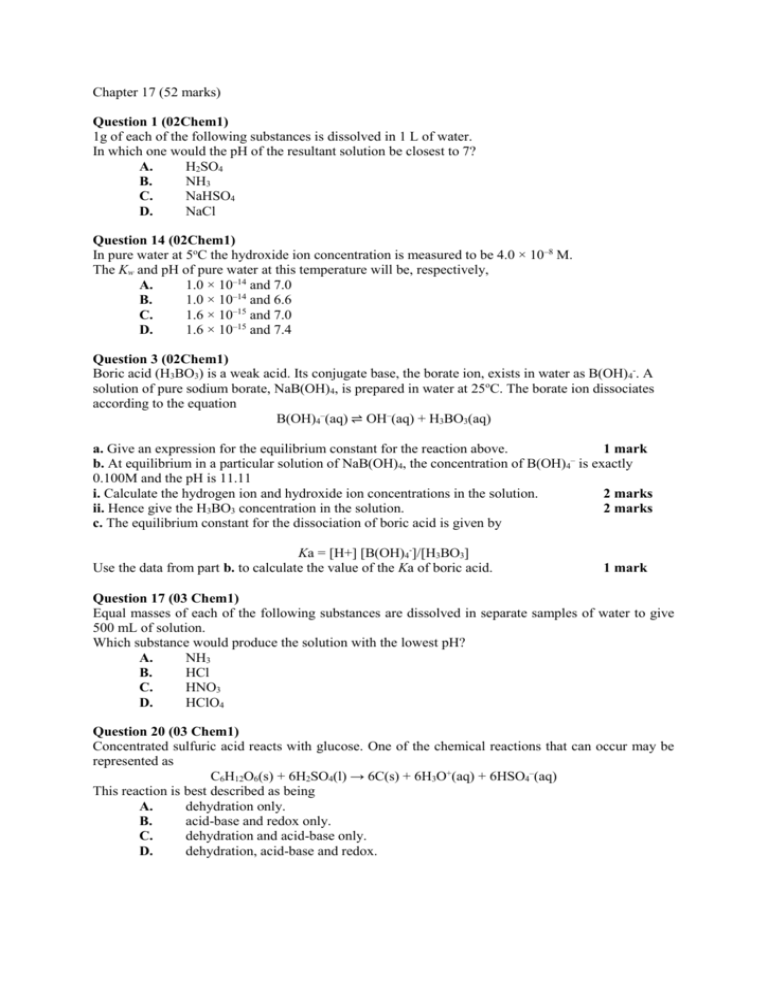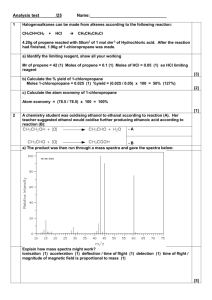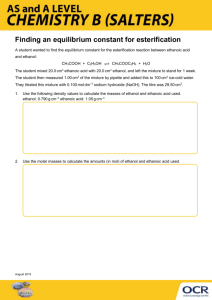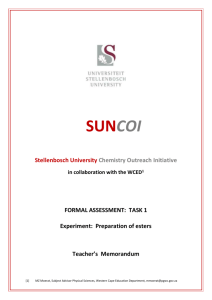Chapter 17 - CSC-year-12
advertisement

Chapter 17 (52 marks) Question 1 (02Chem1) 1g of each of the following substances is dissolved in 1 L of water. In which one would the pH of the resultant solution be closest to 7? A. H2SO4 B. NH3 C. NaHSO4 D. NaCl Question 14 (02Chem1) In pure water at 5oC the hydroxide ion concentration is measured to be 4.0 × 10–8 M. The Kw and pH of pure water at this temperature will be, respectively, A. 1.0 × 10–14 and 7.0 B. 1.0 × 10–14 and 6.6 C. 1.6 × 10–15 and 7.0 D. 1.6 × 10–15 and 7.4 Question 3 (02Chem1) Boric acid (H3BO3) is a weak acid. Its conjugate base, the borate ion, exists in water as B(OH)4-. A solution of pure sodium borate, NaB(OH)4, is prepared in water at 25oC. The borate ion dissociates according to the equation B(OH)4–(aq) ⇌ OH–(aq) + H3BO3(aq) a. Give an expression for the equilibrium constant for the reaction above. 1 mark – b. At equilibrium in a particular solution of NaB(OH)4, the concentration of B(OH)4 is exactly 0.100M and the pH is 11.11 i. Calculate the hydrogen ion and hydroxide ion concentrations in the solution. 2 marks ii. Hence give the H3BO3 concentration in the solution. 2 marks c. The equilibrium constant for the dissociation of boric acid is given by Ka = [H+] [B(OH)4-]/[H3BO3] Use the data from part b. to calculate the value of the Ka of boric acid. 1 mark Question 17 (03 Chem1) Equal masses of each of the following substances are dissolved in separate samples of water to give 500 mL of solution. Which substance would produce the solution with the lowest pH? A. NH3 B. HCl C. HNO3 D. HClO4 Question 20 (03 Chem1) Concentrated sulfuric acid reacts with glucose. One of the chemical reactions that can occur may be represented as C6H12O6(s) + 6H2SO4(l) → 6C(s) + 6H3O+(aq) + 6HSO4–(aq) This reaction is best described as being A. dehydration only. B. acid-base and redox only. C. dehydration and acid-base only. D. dehydration, acid-base and redox. Question 2 (03 Chem1) Part of the Contact Process for the manufacture of sulfuric acid involves the conversion of sulfur dioxide to sulfur trioxide, as shown by the equation 2SO2(g) + O2(g) ⇌ 2SO3(g) ΔH = –192 kJ mol–1 As part of a laboratory study of this process, a container was filled with an equilibrium mixture of sulfur dioxide, sulfur trioxide and oxygen in the presence of a catalyst. The container was initially at 450oC. The container had a fixed volume and was thermally well insulated. Concentrations during a following experiment are shown on the diagram below. a. What change occurred at the 10 minute point? 1 mark b. Which components of the equilibrium mixture are represented by X and Y? 1 mark c. Give explanations for the changes in concentration that occur in X, Y and O2 between 10 and 20 minutes. 3 marks d. Would the temperature of the mixture increase, decrease or remain the same between 10 and 20 minutes? Explain your reasoning. 2 marks Question 4 (03 Chem1) Methanoic acid HCOOH is a weak acid present in the sting of some ants. It ionises in water according to HCOOH(aq) ⇌ HCOO–(aq) + H+(aq) Ka = 1.8 × 10–4 at 25oC a. Explain the meaning of the terms ‘weak acid’ and ‘strong acid’. 2 marks b. Write the expression for the Ka of methanoic acid. 1 mark c. Assuming a small degree of dissociation, calculate the concentrations of H+(aq) and HCOO–(aq) in 0.10 M methanoic acid at 25oC. 2 marks Question 6 (03 Chem1) a. The Earth’s oceans contain significant amounts of dissolved carbon dioxide. The dissolving process can be described by the following chemical equilibria. CO2(g) ⇌ CO2(aq) CO2(aq) + H2O(l) ⇌ H+(aq) + HCO3–(aq) Use this information to explain the likely effect of the increasing concentration of atmospheric CO2 on the pH of seawater at the ocean surface. 3 marks b. Several different acid-base systems contribute to the hydrogen ion concentration in blood. One of these systems is represented by the equilibrium CO2(aq) + H2O(l) ⇌ H+(aq) + HCO3–(aq) Ka = 7.9 × 10–7 The concentration of CO2(aq) in freshly oxygenated blood is approximately 1.3 × 10–5 M and the pH of blood is 7.4. i. Calculate the concentration of the hydrogen ion, H+, in fresh blood. 1 mark ii. Calculate the concentration of the hydrogen carbonate ion, HCO3–, in fresh blood. 2 marks Questions 14, 15 and 16 refer to the following information NaOCl is completely dissociated in water to form Na+(aq) and OCl–(aq). In solution, OCl– hydrolyses according to the equation OCl–(aq) + H2O(l) ⇌ HOCl(aq) + OH–(aq) (1) Question 14 (04 Chem1) 100 mL of pure water at constant temperature is added to a 100 mL solution of 0.10 M NaOCl. When the solution reaches equilibrium again, the A. [H+] has decreased. B. pH of the solution has decreased. C. concentration of HOCl has increased. D. value of the equilibrium constant has halved. Question 15 (04 Chem1) If K1 is the equilibrium constant for the reaction (1) above, then the value of K2, the equilibrium constant for the reaction 2OCl–(aq) + 2H2O(l) ⇌ 2HOCl(aq) + 2OH–(aq) (2) at the same temperature, is equal to A. K1 B. 2 × K1 C. 4 × K1 D. K12 Question 16 (04 Chem1) The HOCl produced in a solution of NaOCl can react further to produce small amounts of chlorine, Cl2(aq), in water according to the equation HOCl(aq) + H+(aq) + Cl–(aq) ⇌ Cl2(aq) + H2O(l) Which of the following, when added to a solution of NaOCl, would not raise the concentration of Cl2 in the solution? A. NaCl B. NaOH C. H2SO4 D. HOCl Question 17 (04 Chem1) The Ka of hydrofluoric acid, HF, is 6.8 × 10–4. The pH of a 0.10 M solution of HF in water is closest to A. 1 B. 2 C. 3 D. 4 Question 4 (05 Chem1) Deuterium (symbol D) is an isotope of hydrogen. Water made from deuterium has the symbol D2O and has similar properties to normal water. D2O ionises according to the equilibrium D2O ⇌ D+ + OD+ -16 2 Kd = [D ] [OD ] = 1.82 x 10 M at 25°C. In a neutral solution of pure D2O at 25°C the concentration of D+, in mole per litre, is A. 1.00 x 10-7 B. 1.35 x 10-8 C. 0.91 x 10-16 D. 1.82 x 10-16 Question 12 (05 Chem1) A solution of sodium hydroxide (NaOH) has a pH of 10. 10 mL of this solution is mixed with 990 mL of water. The pH of the diluted solution is closest to A. 8 B. 9 C. 11 D. 12 Question 13 (05 Chem1) 20.0 mL of 0.10 M hydrochloric acid (HCl) reacts with 20.0 mL of 0.30 M potassium hydroxide (KOH) solution. The concentration of potassium ions in the resultant solution, in mole per litre, is A. 0.10 B. 0.15 C. 0.20 D. 0.30 Question 7 (05 Chem1) Ethanoic acid (CH3COOH) is a weak acid in water. a. Write an equation showing the ionisation of ethanoic acid in water. 1 mark b. A 0.100 M solution of ethanoic acid in water at 25°C has a pH of 2.88. i. Calculate the hydrogen ion concentration in a 0.100 M solution of ethanoic acid. 1 mark ii. Calculate the acidity constant of ethanoic acid at 25°C. 2 marks c. At 25°C, methanoic acid (HCOOH) has an acidity constant that is approximately ten times greater than the acidity constant of ethanoic acid. i. Comparing two 0.10 M solutions of methanoic and ethanoic acids, which solution would have the higher pH? Give a simple qualitative explanation for your answer. 1 mark ii. Equal volumes of both solutions were titrated against a 0.10 M solution of NaOH. Which of the solutions, if either, would require the greater volume of the NaOH solution for complete neutralisation? Explain your conclusion. 2 marks Question 5 (06 Chem1) Sulfuric acid (H2SO4) and nitric acid (HNO3) are both strong acids. Ethanoic acid (CH3COOH) is a weak acid. 20.00 mL solutions of 0.10 M concentration of each of these three acids were separately titrated with a 0.10 M solution of sodium hydroxide (NaOH). In order to react completely A. all three acids would require the same amount of NaOH. B. HNO3 would require more NaOH than CH3COOH but less than H2SO4. C. H2SO4 and HNO3 would require the same amount of NaOH but CH3COOH would require less. D. CH3COOH and HNO3 would require the same amount of NaOH but H2SO4 would require more. Question 12 (06 Chem1) The concentration of K+ ions in 100 mL of 0.0500 M K2CO3 solution, in g L.1, is A. 0.196 B. 0.391 C. 1.96 D. 3.91 Question 17 (06 Chem1) Methanoic acid and ethanoic acid are both weak acids with the following acidity constants. Ka in M at 25oC methanoic acid (HCOOH) 1.82 × 10-4 ethanoic acid (CH3COOH) 1.74 × 10-5 Two separate solutions were prepared, one of 0.1 M methanoic acid and the other of 0.1 M ethanoic acid. Which one of the following would be present in the highest concentration at 25oC? A. CH3COOH in the ethanoic acid solution B. CH3COO- in the ethanoic acid solution C. HCOOH in the methanoic acid solution D. HCOO- in the methanoic acid solution Questions 15 and 16 refer to the following information. One litre of an aqueous solution of potassium hydroxide (KOH) has a pH of 12.0 at 25°C. Question 15 (07 Chem1) The amount of solid KOH, in mol, that must be added to the solution to raise the pH to 13.0 would be A. 10.13 B. 10.12 C. 0.09 D. 0.10 Question 16 (07 Chem1) The amount of pure HCl gas, in mol, that must be added to the solution to lower the pH from pH 12.0 to 2.0 would be A. 10 B. 2.0 C. 0.02 D. 0.01 Question 2 (07 Chem1) Bromophenol blue is a weak acid (represented as BH) that acts as an acid-base indicator. In solution the following equilibrium is established. BH(aq) ⇌ B-(aq) + H+(aq); Ka = 6.3 × 10-5 M (yellow) (blue) At low pH bromophenol blue exists mainly as the acid, BH, which is yellow in colour, while at high pH it exists mainly as its conjugate base, B-, which is blue. An intermediate colour is observed when the concentration of the acid and the concentration of the conjugate base are similar. a. Write an expression for Ka in terms of the concentrations of BH, B- and H+. 1 mark b. i. When [BH] = [B ], the mixture appears green. Calculate the pH at which [BH] = [B ].2 marks ii. Calculate the ratio [B-]/[BH] when the pH of a solution of bromophenol blue is 7. 1 mark iii. What colour will the indicator solution appear at pH 7? Justify your answer. 1 mark








